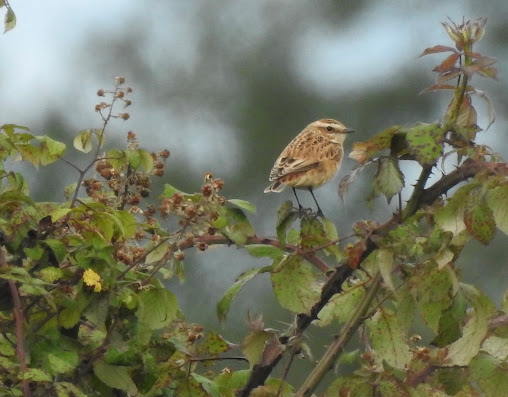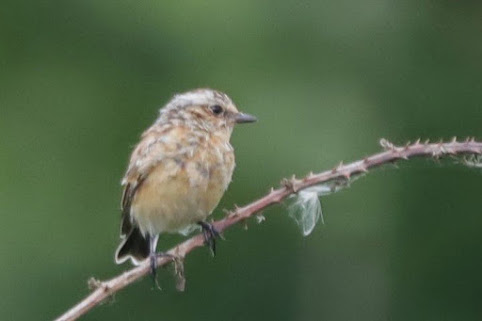Before I get to the thrust of today's post I want to share my good fortune. Yesterday, Lyn and I were surveying our garden from the door of the utility room with divergent opinions. I regard a messy garden as a good garden, Lyn doesn't. The coup de gras for my argument was delivered when I noticed a smallish orangish butterfly fluttering just beyond the lawn. I couldn't quite work out what it was, so I stepped out for a closer look. Seconds later Lyn was startled to see me dashing back in, swearing for England. I had just realised it was a Brown Hairstreak and I needed my camera.
 |
| Brown Hairstreak co-operating |
Fortunately it was still there and the above shot confirms my first hairstreak of any species for the garden, and my third Brown Hairstreak ever.
Anyway, cast your mind back to the weekend. I was unable to get to Morton Bagot on Bank Holiday Monday, but received several messages from disappointed birders. Evidently the Goshawk did not reappear. One member of the Earlswood Group commented that Morton was "dead". This should have put me off, but if anything it spurred me on.
I visited Morton Bagot on Tuesday morning determined to prove it was not dead at all. After three hours of searching I can announce it is alive.....but asleep. Yes, I quite enjoyed the morning but didn't find anything better than a Sand Martin. My 46 species also included a calling Willow Warbler, a flock of 41 Lesser Black-backed Gulls heading south-west, and not much else. It doesn't bode well for the Westmidsalldayer, although I do at least have a team now. It'll be me, Gary J, Martin W, and maybe Dave unless the allure of Marsh Lane proves irresistible.
The sad fact is that Morton Bagot is second division (or third) when it comes to bird species richness compared to most of the other competitors. Our nearest neighbour is Earlswood Lakes, and we traditionally take a pasting. But this year Earlswood's water-level is high while ours is not. Perhaps there's a chance.
This morning I went to check Earlswood out. I want to say it was rubbish, but 48 species tell me it wasn't. The highlight was a Hobby chasing the 100+ Swallows over Windmill Pool. Among the hirundines was a Sand Martin and two Swifts. We'll struggle for them on Saturday.
Over the causeway flew a Meadow Pipit (my first of the autumn) and seven Siskins. Waterfowl included the resident Wigeon and a hybrid WigeonXsomething (Mallard?), Great Crested Grebes, Tufted Ducks, Shoveler, Coot. Yep, we haven't even got a Coot at Morton Bagot.
 |
| Grey Wagtail (slight chance) |
 |
| Coot (not optimistic) |
 |
| Great Crested Grebe - in my dreams |
It's looking grim, but consider this. We've got mud = waders. We've got a lot of bushes = warblers.
One thing's for certain. All the teams will have a great time. Bring it on.
 |
| The hybrid |




























